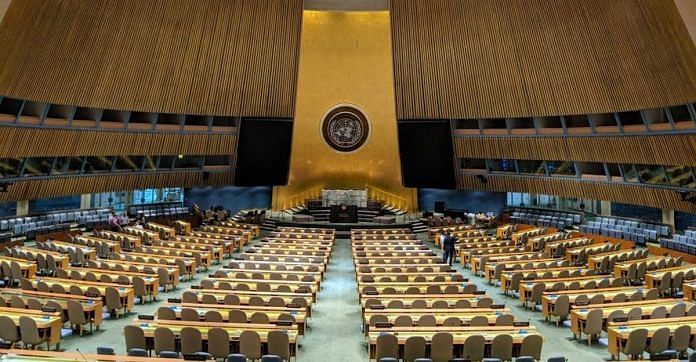
New Delhi: The draft resolution moved by the US — backed by the UK and France — at the UN Security Council (UNSC) to blacklist Jaish-e-Mohammed chief Masood Azhar could turn out to be yet another tardy process that may end with China exercising its right to veto the decision.
“The draft has not even been discussed so no timeline can be put in this matter,” a top official told ThePrint on condition of anonymity. “However long the (UN security) council may take, it will be less than the 10 years that the (UNSC 1267 Al-Qaida Sanctions) committee has taken to list Masood Azhar.”
While at the UNSC 1267 Al-Qaida Sanctions Committee, there is a time-frame to act on a resolution — and many can be introduced and defeated over the years — at the Council it’s open-ended. This is because the committee functions on the principle of consensus while at the council it is based on the vote.
However, the only difference between the previous attempt to list Azhar as a global terrorist and now is that this is the first such attempt made by the US, and China has never publicly voted against Azhar or explained the rationale for a vote, the official said.
But the issue here is that the UNSC would need nine votes to adopt the resolution in blacklisting Azhar and they include the five votes of its permanent members, or the P-5, with the other four to come from its remaining 10 members.
The UNSC has five permanent members and 10 non-permanent members.
Also read: United Nations is far too necessary to be written off
Move symbolic, says expert
“It’s a symbolic move, meant to convey both Washington’s strong opposition to China’s block and the unrelenting US support to India on the Azhar issue,” said Michael Kugelman, deputy director of the Asia Program and Senior Associate for South Asia at the Washington-based Wilson Centre.
Unlike in the sanctions committee, when a resolution is moved at the council, intense discussions take place among members. So, by moving the resolution, the US has opened a channel to discuss the matter directly with China.
Under the committee, there is no discussion that takes place and the listing is done through a ‘No Objection’ procedure whereby the country objecting — which in this case was China — simply sends send a note and ends the process by placing a technical hold for nine months and then blocking listings.
In case of the US resolution, however, it will have to be presented to the UNSC secretariat, which will then discuss the matter, after which it will adopt the resolution and thereafter call for voting on a specific date.
According to the diplomatic sources, this is “just another way” to build pressure on China. If China does not vote and vetoes the move, then it will not be seen internationally as a proponent of counter-terrorism.
“The US may calculate that China will look doubly bad if it goes against the international consensus once again and does another veto, and will, therefore, let the resolution go through this time,” said Kugelman, an expert on India, Pakistan and Afghanistan.
“That’s a fair point, but I don’t see why China would have any less incentive to veto now than it did a few weeks back.”
On 13 March, China had placed a technical hold seeking more time on a proposal to list Azhar as an international terrorist. Imposing sanctions on him will entail assets freeze, travel ban and arms embargo. This was the fourth such attempt since 2009 to list the JeM founder at the UN.
The proposal was put forward by the US, UK and France after the Pulwama terror attack masterminded by JeM killed 40 CRPF personnel.
Also read: US again slams China on Masood Azhar, raises Uighur Muslims issue

COMMENTS